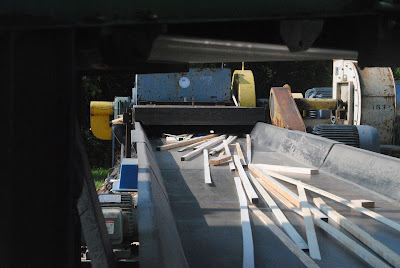On our follow up trip we went to Sutton, WV. We drove up the evening before our tours and had a WONDERFUL dinner at a Bed and Breakfast called Cafe Cimino.
Rise and shine . . . the next morning we were off to the
Weyerhauser
Sutton OSB plant for our first tour of the day.
The plant was started in 1996 and now employs 135. At its peak, the plant employed 170 local people (in 2006). It is the only OSB Weyerhauser plant in WV. They pull logs from as many local timber companies but can pull as far as North Carolina. The plant runs most all kinds of wood but tries to do no more than 10% pine.
In the log yard, they could have a storage of logs of 110,00 tons that can last 6weeks. They have a crane that unloads the logs in bites onto log decks (there are two). On the chain conveyers, the logs are debarked with chains that hang and sort of "beat" the bark off . The conveyor then carries the logs into what are called "Thaw tunnels". The logs are in the tunnel for 30 minutes at 150 degrees. The bark from the debarking is used to generate the heat for the thaw tunnel.
The logs are then cut into strands by a strander that is 84" in diameter and has 46 knives with a 22 second cycle. The stranders are rebuilt in house which helps save money. Once the logs have been cut into strands, they are screened two ways: rotating and shaking. Once sorted the strands will be used according to their sizes and grouped as either core strands or surface strands.
The strands are then put in a blender and an infrared sensor is used to determine moisture is used to get the right amount of resin added to each batch.
The strands are oriented and then put into forms. They use 4 large forms (12 X 24 feet) which, after pressing, can yield 108 4X8 panels..... in 4 to 6 minutes.
A typical 7 day production week the plant can produce 90 trucks and 48 rail cars a day. But since the plant is only working a 4 day work week right now, they are producing about 60 trucks and 24 rail cars a day.
There is a lot of recycling in the plant and as a matter of fact, it was desigend from the beginning to be a zero discharge facility.
The plant ships to the states of Ohio, Pennsylvania, Indianna and Maryland.


















